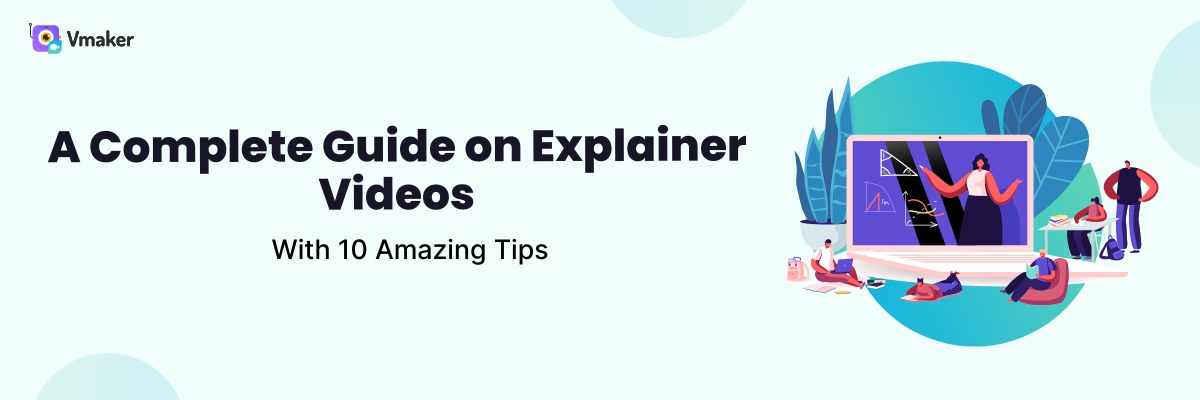Complete Guide on Explainer Videos: With 10 amazing tips
There are numerous tips online for making an explainer video. It’s a good thing because there is no dearth of free knowledge available. But, the problem is that the knowledge is scattered all over the place.
It’s a chaotic experience and no matter how much you love note-taking, it’s exhaustive after a point of time. Therefore, to put an end to this goose chase, we have compiled all the necessary information that you need to know about explainer videos.
Fun fact: This is one of the reasons why 8 out of 10 people prefer watching explainer videos over reading product guides. It’s concise and makes life easier for them.
What is an explainer video?
Understanding the meaning of explainer videos is simply-complicated. It’s simple because you know that it’s a video that explains stuff. Stuff that can be difficult to understand otherwise. The complicated part is its definition. Without help, you can confuse its meaning with the other video types - product videos, educational videos, tutorial videos, and training videos too.
Here’s a short description of each video type so that you know which one is which, and you don’t have to spend time reading the meaning of videos in blogs henceforth.
Explainer video: A short video usually of less than 3-minutes. These videos start by explaining a pain-point or a business problem, and provide a solution for it towards the end.
Product video: A product video specifically talks about the product. It can be a demo or a simple unboxing video - both types will fall under this category.
Educational video: An educational video is long and filled with more details and information. The topics for these types of videos are broad and made with the intention of growing the viewer’s knowledge.
Tutorial video: A tutorial video is a step-by-step walkthrough of how to perform a job or get a job done. These are mostly short videos with the intention of helping the viewer with the task they have in hand.
Training videos: These types of videos are long and are made in series. The idea is to make someone better at performing a task for long-term success.
What are the benefits of explainer videos?
Here’s a list of 10 reasons that make explainer videos so effective -
Easier to remember - Explainer videos are short. Therefore, it’s easier to remember for your audience.
Saves time - Explainer videos are excellent for making an elevator pitch. People can watch a 3-minute explainer video to get an ample overview of a company.
Action-oriented - A well-made explainer video that solves the pain-point and offers the solution will get more action as compared to any other form of content.
More engaging - Watching an explainer video is more engaging than reading a product manual. Because everyone loves watching videos.
Easy storytelling - It’s quite easy to grip your audience with storytelling in explainer videos. As the story can be told in a visual form, the audience feels more connected to the story.
Multipurpose - You can use explainer videos on your website, upload to your YouTube channel, include in your email content and share them on social media.
Great for SEO - Using explainer videos on web pages not only boosts visitor experience, but also optimizes the content for search engines. This means more traffic to your website.
Better ROI - With more traffic, higher engagement and conversions, explainer videos give impressive returns on investment.
Easy to track - Whether you’re hosting it on your website or sharing it on social media, it’s easy to track the views and engagement on a video.
Beats competitors - Surprisingly, not every brand is making an explainer video. Which means that if you do it well and consistently, you can stay miles ahead of your competitors.
Types of explainer videos
The best way of making explainer videos is choosing one type of explainer video maker, and then building expertise in it over time. Choosing the right explainer video maker will depend on your budget and resources.
But, to help you get started, here are the three most common types of explainer video tools used by businesses -
Screen recorded explainer videos
This is a highly popular technique for making explainer videos. A screen recorder is a video making tool that is usually available in the form of software and Chrome extension too. It records screen, webcam, audio and has built-in powerful features that can get the job done very well.
The reason it’s a popular explainer video maker is that anyone can use a screen recorder. It’s all about downloading an app and getting started with it. No technical background is required. It’s also less expensive when compared to other video making tools.
On the flip side, because there is no team to make these videos, you’re on your own. To get better at making these videos, you have to do basic work like practicing to talk in front of the camera and writing a script.
Animated explainer videos
With animation, the storytelling in explainer videos is done with the help of animated characters and illustrations. When compared to screen recording, this technique is poles apart. Because although you’re still the storyteller, working behind the scenes, the protagonists are the characters.
With animation, the explainer videos become more entertaining and these videos are great for explaining a complex idea or introducing an unconventional product. For example, a video on increasing per capita income, and its impact on inflation.
The challenging part about making these videos is that you cannot do it on your own if you don’t have experience doing this. You might have to hire a team or outsource this task to an agency, which makes this process expensive.
Live Action explainer videos
This form of video shows a real-person talking in front of a camera. This type of explainer video is beneficial for building an instant connection with the audience. Live action videos are the most useful for explaining concepts that need a personal touch.
The place where live action videos are perfect at adding value is when you want to build trust with your audience. For example, baby products. A screen recorded video or an animated video can water down your company branding. Or in other words, it will not be as impactful as live action videos. Because when people are looking for baby stuff, they want to see real people using them and look for social proof to determine the safety of the product.
But, these types of videos are expensive. As real actors are hired along with a studio-like set-up and advanced cameras, be ready to set your marketing budget accordingly.
What makes a good explainer video - 9 best tips
So far we have covered the definition, importance and types of explainer videos. You’ve the basic information to start making an explainer video, but here are a few simple tips that you shouldn’t ignore.
1) Keep the video short
We kept this point at the top in spite of mentioning it twice before because this is the most distinct quality of an explainer video. Explainer videos are to the point. It’s like driving from point A to point B. While you make explainer videos, keep reminding yourself about your viewers.
They have limited attention span, and they’re looking for a solution to a problem, ergo they’re desperate. This is the reason why explainer videos that are under 2 minutes get the maximum number of views.
2) Have a single goal
An explainer video should focus on a single goal because more than one goal in a short video will confuse your audience. If it’s tough for you to decide what the goal should be, then try writing a problem statement. This statement is like your anchor or a theme of your video. It will stop you from swaying away from your goal.
While deciding on the goal, also keep in mind what action you want your audience to take at the end of the video. You would not want your audience to leave without checking out your website or filling the sign-up form, right? Making an explainer video with an end result is like closing the loop. You have a clear idea about both - the start and end of your video.
3) Know your target audience
There are tonnes of explainer videos floating around. But, a few of them have more views than all the others combined. You know what would have worked in their favor? Of course, there are going to be multiple parameters, but the common thread is going to be a well-researched content on the target audience. Knowing the audience is the secret sauce. It gives you the headway to customize and personalize your video as per your audience’s interest.
Try knowing about the demographics of your audience, what motivates them and what change they’re trying to make in their life.
4) Follow the problem - solution - CTA approach
The reason behind making an explainer video is to provide a solution to a problem. Therefore, when you make the video, always start with the problem that you intend to solve in the video. This will build an immediate connection with your audience, and they will know that this is the right video for them.
Now comes the solution part. Here’s where you have to keep them engaged. Remember it’s a short video, so if you’re making a product pitch here, keep it snappy. Explain the audience how exactly the problem can be solved with the product. Any product information that is not relevant to the problem should be cut out from the explainer video immediately.
Lastly, the CTA should inspire people to take an action - whether it’s for signing up or scheduling a call. If you have done a good job in the first two, you should expect great results here.
5) Create an outline
The outline is like a brain dump - it sounds weird, but it works. An outline forces you to imagine how you want your explainer video to look like when it’s ready to be shared with others. It puts you in the active mode. We recommend that you put down all the ideas you have in your mind on a piece of paper, note app or a doc. Then try to bring them in a sequence, so that they flow smooth and there is a logical interpretation. This will help with the next step.
6) Write a script
Once your outline is complete, you’re ready to write your script. The difference in outline and script is that a script is more structured and one step ahead of bringing your explainer video live. To write a script, you can write actual dialogues or add points - whatever works for you. The idea is to help you connect the dots and have a proper flow of words while recording.
Once you have a draft ready, we recommend getting it reviewed by someone in your team. A fresh pair of eyes can help you add new ideas or spot mistakes which you might have overlooked while writing. If you need more help about writing a script, you can check out our blog on how to write a YouTube video script.
7) Record in high quality
If you have hired an external agency to make an explainer video for your business, ensure that it’s done in the best quality. If you’re doing it on your own using a screen recorder, then record the video in HD or 4K quality.
Recording in high quality gives your audience the assurance that you have tried your best to provide the best video experience. On the other hand, if the video quality is poor, it sends a negative message to your audience about your brand.
8) Add subtitles to your explainer video
Subtitles make it easier for your audience to follow the video. In spite of making a high quality video, your audience might find it difficult to follow the video. There could be many reasons like different accents or limited proficiency in the audio language. Adding captions to your video is also not that tough. You can upload the script file in SRT format and that should do it.
But, we suggest you try using a free subtitle generator tool that recognizes the audio language and generates captions automatically. All you have to do is download the file and upload it in an editor to sync the video with the subtitle.
9) Utilize AI Video Editing Tools for Professional Polish
In today's digital landscape, utilizing AI video editor can elevate the quality of your content to professional levels. These tools offer advanced features such as automatic scene detection, video background removal, and text-to-video conversion, streamlining the editing process and enhancing the visual appeal of your videos.
By harnessing the power of AI, you can achieve seamless transitions, crisp visuals, and captivating effects with minimal effort. Whether you're creating marketing videos, educational content, or social media posts, AI video editing tools provide the polish and professionalism necessary to stand out in a crowded online space.
With intuitive interfaces and intelligent algorithms, these tools empower creators of all skill levels to produce high-quality videos that resonate with their audience. Whether you're looking to schedule social media posts efficiently or craft compelling video narratives, these tools provide the flexibility and functionality needed to thrive in the digital age. Say goodbye to hours spent on manual editing tasks and hello to a streamlined workflow that delivers exceptional results every time.
Wrapping it up
Making an explainer video is an excellent way to create engagement and build traffic to the website. It has many other benefits, but before you do that, ensure that you’re clear about the type of explainer video you want to create. Choose an explainer video maker that you’re most comfortable with and keep getting better at it.
Along with that, follow the 9 tips that we shared with you above. It will give you a great head start, and in the end, you will have an excellent quality explainer video ready to be shared with your audience.
Recommended Readings:
7 Best Explainer Video Software For Windows and Mac
Top 10 Styles of Animated Explainer Videos (With Examples)
How Does Video Storytelling Help Create The Best Explainer Videos?
How to Increase Feature Adoption with Explainer Videos Using Vmaker
How to Create an Instructional Video | Pro Tips & Best Tools



